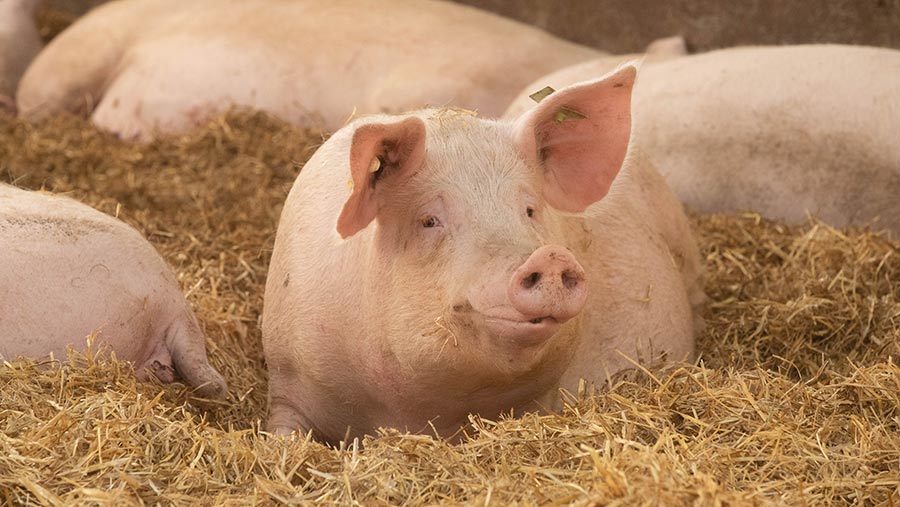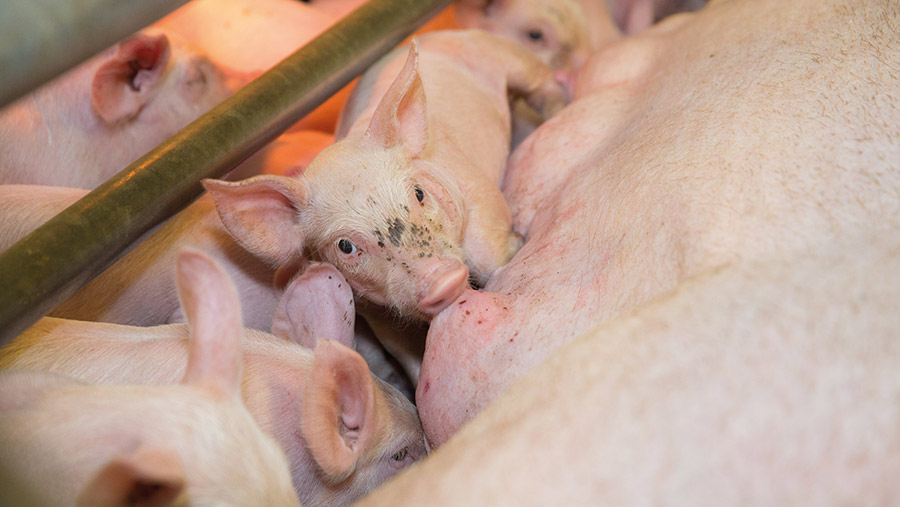7 tips on maintaining sow body condition
 Sow house, National Pig Centre © Tim Scrivener
Sow house, National Pig Centre © Tim Scrivener Managing sows so they neither gain nor lose too much body condition between parities should be the ambition of every pig breeder, as this single measure directly impacts on a herd’s economic performance.
This is according to pig consultant Stephen Hall, who says on average 50% of all replacement gilts fail to reach parity 5 – the benchmark of an economically efficient cycle.
Drop outs are mostly related to body condition score, he says. “It is the underlying reason why most breeding females are culled,” he points out.
See also: Advice for selecting and managing gilts up to service
Simon Cook, of pig breeding company Rattlerow, says this situation arises because farmers are often not given sufficient information by their suppliers on the condition they should target in a gilt at first farrowing.
“That target needs to be understood by the farmer so that they can manage the animal correctly and keep it in the herd for longer,” he says.
Mr Cook and Mr Hall give their tips on what producers can do to lift more sows to optimum longevity by maintaining condition.
1. Ensure replacements have sufficient backfat at first farrowing
Aim for 18mm backfat at the point of first farrowing.
A gilt can lose an average of 4mm over her four-week lactation. It is critical for her to return to the boar with 14mm backfat, says Mr Cook.
“What you don’t want is a situation where that animal has 14mm or less of backfat at farrowing and returns to the boar with 10mm, because she will be constantly trying to catch up until she gets to parity 3.
“These animals often don’t make it to parity 2.”
2. Target the correct body condition score
On a body condition scoring (BCS) system of 1-5, which scores from emaciated to grossly fat, Mr Hall advises 3.5-4 at the point of farrowing.
“I would suggest aiming more towards 4, but it does vary from genetics to genetics and from farm to farm.”
At lactation, he recommends not letting condition fall by more than half a score. “This is very important because lactation is the most valuable period in the production cycle of any sow.”
Any gilt or sow with poor BCS during her lactation will prevent the herd as a whole from achieving its full economic potential, he adds.
“We often hear about parity 2 drop – poor management of body condition in that first lactation has a big influence on that.”
Condition scoring will minimise overfeeding and, as a consequence, feed costs. It will also identify sows that need additional feed to achieve the ideal body condition at farrowing.
Mr Hall says quarterly vet visits are a valuable opportunity to assess BCS across the herd.
“Ideally the BCS of each sow should be assessed several times during the reproductive cycle.”

© Tim Scrivener
3. Assess the diet
Sows need sufficient minerals and energy in their diet to achieve optimal performance. BCS, backfat probing or weighing will help indicate if that is being achieved.
Farmers should ask their nutritionist to visually assess the pigs and identify current intakes so that diets can be adjusted if needed.
They should aim to do this every quarter initially and every six months once performance is where it needs to be, says Mr Cook.
“A nutritionist needs to evaluate feed presentation, wastage and bin management by visiting the farm at regular intervals.”
4. Reformulate the ration of lower-conditioned sows
Feed intakes vary from one sow to the next and some will have smaller appetites.
Those animals need a high-specification diet to get the correct level of nutrition. Farmers should seek advice from their genetic supplier and nutritionist.
5. Identify elite sows as an example marker
For managing BCS, it is useful to identify the best sows in the herd at different parity levels. These can be used as a benchmark for the ambition of the herd overall.
“Consider what you are doing well with these ‘perfect’ animals, and what are you not doing so well with animals that aren’t where you want them to be,” Mr Hall suggests.
If the ambition is to have fifth-parity sows that consistently wean a litter of 12 on average, work out why that is not being achieved with every sow, he advises.
“The data of every cull sow should contain more information about why she was culled than is currently recorded in most herds.”
6. Calibrate feeders
While the diet formulation might be balanced, volume density can be in flux, with little control of density from one milled load to the next.
“Density can vary enormously, and even more so with home milling with the inclusion of straights,” says Mr Hall. “It can change over a period of time, but on a day-to-day basis, producers rarely see that.”
He encourages farmers to regularly weigh feed if they are manually feeding, or to weigh drops over a 24-hour period when using automatic feeding.
If weights are not as anticipated, adjust feed levels to ensure sows receive the correct ration.
7. Segregate sows according to body condition
Mr Hall advocates a transition from multiparous service groups to single-parity service groups to establish a strong foundation within a herd for maximum economic efficiency.
This system involves running each batch of replacements as an exclusive group and adopting a strategy of zero mixing between service groups.
This can be achieved by introducing the calculated replacement requirement in weeks one, four, seven and so on for weekly production, and in weeks one, 10, 19 and so on in three-weekly production.
In weekly production, it will take 108 weeks to achieve a complete transition, says Mr Hall, and three times longer in three-weekly production.
However, the transition does not impact the continuous flow output of the business.
This system is based on the development of pig husbandry that manages the process controls associated with the Gilt Watch Together system, which identifies and commands process controls that include sow retention and herd structure.
The one caveat to this transformation is that it must be a five-week weaning system, with an average farrowing index of 154 days.
“This is proving to be the weaning age that optimises the genetic potential of many commercial sire-lines in terms of authentic economic efficiency,” says Mr Hall.
“Economically, ethically and environmentally, it makes sense because of the efficiencies it creates.”
How to score a sow’s body condition
AHDB advises scoring sows by touch, using the palm of the hand, and by sight where this is not possible.
Score the sows on a scale of 1 to 5 and use half scores for mid-ranges.
- Emaciated: shoulders, individual ribs, hips and backbone are visually apparent
- Thin: shoulders, ribs, hips and backbone are quite easily felt when pressure is applied with the palm of the hand
- Acceptable/optimal: shoulders, ribs, hips and backbone can only be felt when pressure is applied
- Fat: shoulders, ribs, hips and backbone cannot be felt even when pressure is applied
- Grossly fat: fat deposits are clearly visible
